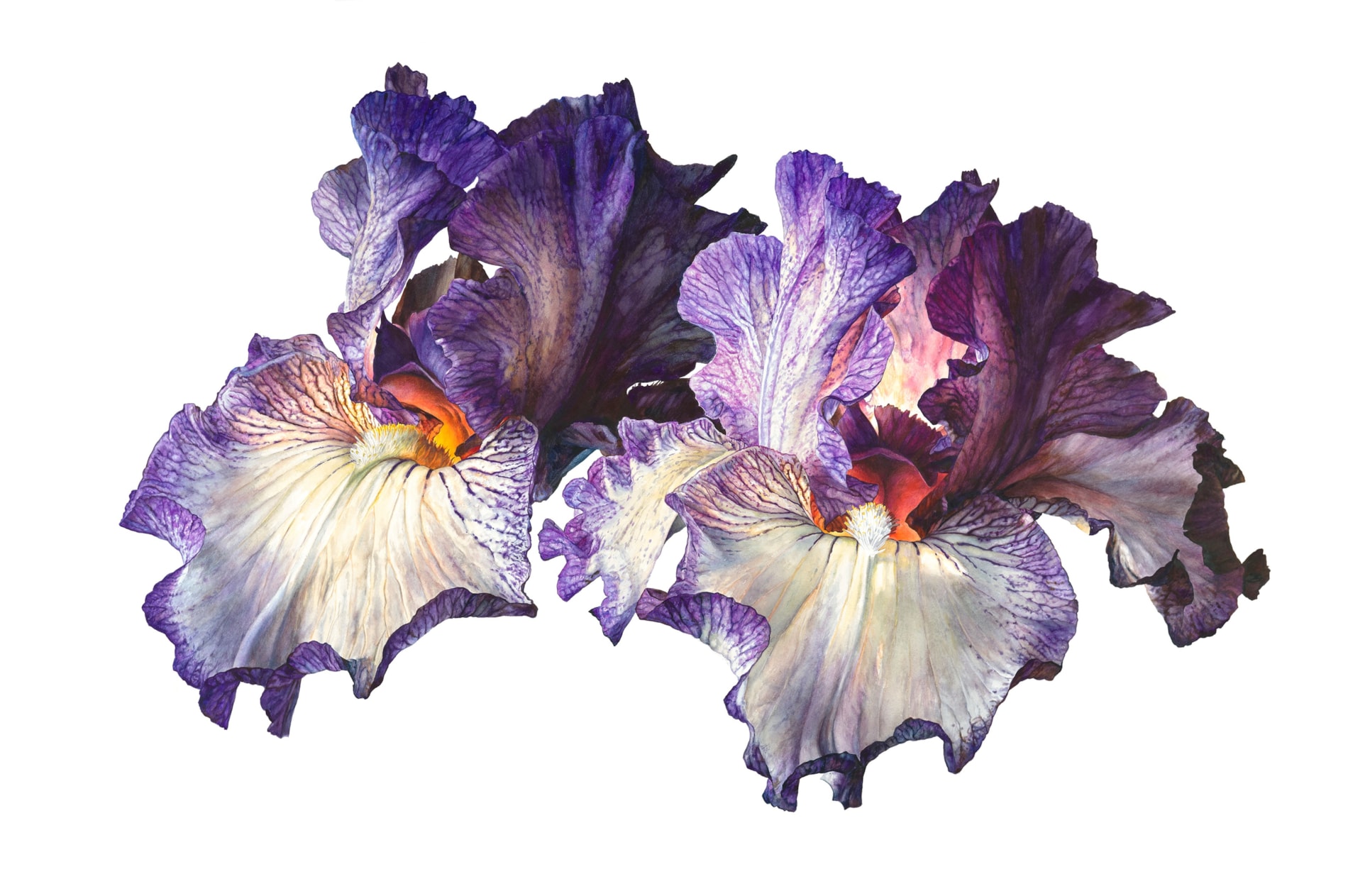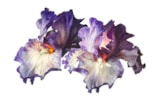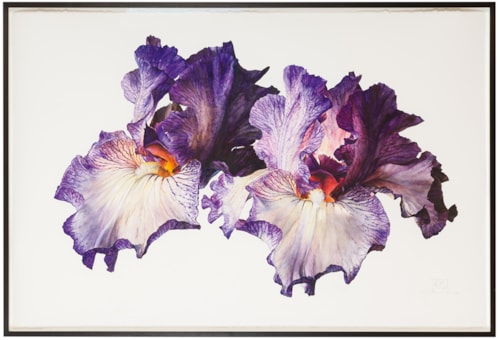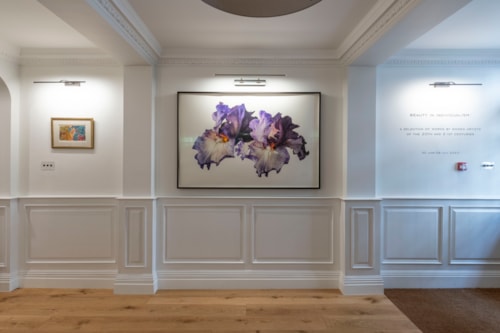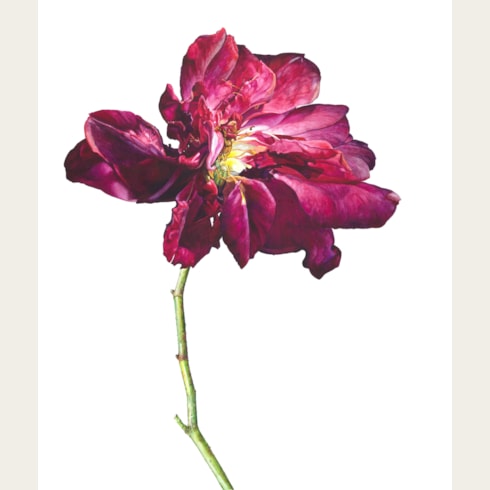Rosie SANDERS
( 1944)
Heart of Darkness
Sold
Watercolour on Arches paper.
Signed with the artist’s initials RS at the lower right.
1002 x 1540 mm. (39 1/2 x 60 5/8 in.)
Signed with the artist’s initials RS at the lower right.
1002 x 1540 mm. (39 1/2 x 60 5/8 in.)
As one critic has noted of the artist’s watercolours, ‘If traditional botanical drawings capture a flower’s scientific qualities then Rosie Sanders’s paintings celebrate its visceral beauty. Back-lit andblown up out of proportion, they are the sensual stars of Sanders’ canvases, ripe wth colour and movement. While meticulously realistic in execution, they are also larger than life and always painterly...As well as a lustrous quality, her work also has a realism that delights in her subject’s imperfections. A keen gardener, many of Sanders’s blooms are picked from her own garden or grown in her greenhouse and while she will source some from florists, they rarely have the drama her paintings require…Painting is an obsession for Sanders, who pours passion into each piece of work.’
Irises make up a significant proportion of Sanders’s watercolours of flowers. As she has stated, ‘Irises I actually love, it’s one of my most favourite things…Irises are so…sensual and voluptuous and there’s something about the way [the] petals come out…and it’s that that I…want to get the feel of.’ In another interview, Sanders added that ‘I tend to go with the plant. If it moves a bit, I’ll go with it. With irises I would have quite a few Gardening stems because they don’t last long enough for you to do the whole painting. I probably get one large petal done in a day and you come down next morning and it’s died. Then you simply splice another one in…I do like subjects that have a certain presence. I am not so keen on orchids now, they are a bit stiff, whereas irises are so soft and sexy but have this incredible strength. They are like women. They don’t get blown over, they stand tall. They are powerful and feminine.’
Irises make up a significant proportion of Sanders’s watercolours of flowers. As she has stated, ‘Irises I actually love, it’s one of my most favourite things…Irises are so…sensual and voluptuous and there’s something about the way [the] petals come out…and it’s that that I…want to get the feel of.’ In another interview, Sanders added that ‘I tend to go with the plant. If it moves a bit, I’ll go with it. With irises I would have quite a few Gardening stems because they don’t last long enough for you to do the whole painting. I probably get one large petal done in a day and you come down next morning and it’s died. Then you simply splice another one in…I do like subjects that have a certain presence. I am not so keen on orchids now, they are a bit stiff, whereas irises are so soft and sexy but have this incredible strength. They are like women. They don’t get blown over, they stand tall. They are powerful and feminine.’
A recipient of several awards for her horticultural studies, Rosanne (Rosie) Sanders has developed a reputation as one of the finest botanical artists working today. Apart from taking a foundation course at the High Wycombe College of Art, however, she is largely self-taught as an artist. Sanders started her career as a botanical painter in 1974, soon developing a particular reputation for her striking watercolours of flowers and fruit. She has earned commissions from the late Queen Elizabeth II and Queen Elizabeth The Queen Mother, as well as the Royal Horticultural Society, from whom she has won several gold medals for botanical illustration.
As the collector and scholar of botanical art Shirley Sherwood has written, ‘Rosanne Sanders was introduced to me as the ‘Apple Lady’ because of her superlative studies of fruit.’ In 1988 Sanders wrote and illustrated a book entitled The English Apple, which was followed in 2010 by The Apple Book. In 2015 and 2016 a lavish monograph, Rosie Sanders’ Flowers: A Celebration of Botanical Art, was published in English, German and Spanish editions, while a book devoted to the artist’s watercolours of various types of roses appeared in 2019. In recent years the artist has been working on a series of large-scale monochromatic studies of woodland landscapes drawn in graphite and charcoal. Sanders lives and works in Devon, and has exhibited widely in London and elsewhere during a career that has lasted nearly fifty years. Her work is today in the collections of the Hunt Institute for Botanical Documentation in Pittsburgh and the Yale Center for British Art in New Haven, Connecticut, as well as the Shirley Sherwood Collection of contemporary botanical art at the Royal Botanical Gardens in Kew.
Sanders is best known for her watercolour drawings of flowers, usually on a very large scale. In her studio, she strongly backlights the flowers, the better to capture the translucency and texture of the petals to their full advantage, and often studies them from unusual angles. As the artist has noted, ‘I felt I wanted to be an artist and not an illustrator. It’s part of my nature, I’ve never liked being in a tradition. So I have tried hard to see a different view of a plant…I can’t just sit down and paint me an orchid. It is about my response to the flowers. Something happens when I am painting and it’s not necessarily conscious.’
Elsewhere, Sanders has expounded on her process; ‘I spend a great deal of time thinking about my next painting before I ever begin to put paint to paper…It’s hard to say what I am looking for, or why I choose a particular plant or flower, but I think generally it is shape and colour. It is not of prime concern to me what type the plant is, so while the subjects are plants, the paintings are not botanical in the traditional way. Having said that, it is important that I am true to the nature and form of the plant I have chosen; the paintings have a description of great particularity.’
As the collector and scholar of botanical art Shirley Sherwood has written, ‘Rosanne Sanders was introduced to me as the ‘Apple Lady’ because of her superlative studies of fruit.’ In 1988 Sanders wrote and illustrated a book entitled The English Apple, which was followed in 2010 by The Apple Book. In 2015 and 2016 a lavish monograph, Rosie Sanders’ Flowers: A Celebration of Botanical Art, was published in English, German and Spanish editions, while a book devoted to the artist’s watercolours of various types of roses appeared in 2019. In recent years the artist has been working on a series of large-scale monochromatic studies of woodland landscapes drawn in graphite and charcoal. Sanders lives and works in Devon, and has exhibited widely in London and elsewhere during a career that has lasted nearly fifty years. Her work is today in the collections of the Hunt Institute for Botanical Documentation in Pittsburgh and the Yale Center for British Art in New Haven, Connecticut, as well as the Shirley Sherwood Collection of contemporary botanical art at the Royal Botanical Gardens in Kew.
Sanders is best known for her watercolour drawings of flowers, usually on a very large scale. In her studio, she strongly backlights the flowers, the better to capture the translucency and texture of the petals to their full advantage, and often studies them from unusual angles. As the artist has noted, ‘I felt I wanted to be an artist and not an illustrator. It’s part of my nature, I’ve never liked being in a tradition. So I have tried hard to see a different view of a plant…I can’t just sit down and paint me an orchid. It is about my response to the flowers. Something happens when I am painting and it’s not necessarily conscious.’
Elsewhere, Sanders has expounded on her process; ‘I spend a great deal of time thinking about my next painting before I ever begin to put paint to paper…It’s hard to say what I am looking for, or why I choose a particular plant or flower, but I think generally it is shape and colour. It is not of prime concern to me what type the plant is, so while the subjects are plants, the paintings are not botanical in the traditional way. Having said that, it is important that I am true to the nature and form of the plant I have chosen; the paintings have a description of great particularity.’

